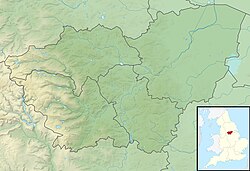Ulley reservoir
| Ulley Reservoir | |
|---|---|
 |
|
| Location | South Yorkshire |
| Coordinates | 53°22′48″N 1°18′50″W / 53.3800°N 1.3140°WCoordinates: 53°22′48″N 1°18′50″W / 53.3800°N 1.3140°W |
| Type | reservoir |
| Primary inflows | Ulley and Morthen brooks |
| Basin countries | United Kingdom |
| Surface area | 35 acres (14 ha) |
| Average depth | 46 feet (14 m) |
Ulley Reservoir is a reservoir a few hundred yards to the west and downhill of the village of Ulley, 4 miles (6.4 km) south of Rotherham, South Yorkshire, England. It is 2.5 miles (4 km) away from junction 33 of the M1 motorway.
The reservoir was built in 1871 by damming the brooks of Ulley and Morthen, to provide the town of Rotherham with approximately 180 million gallons (820 million litres) of drinking water per year. There are two main ponds; the larger one is used for angling and dinghy sailing, and the smaller one is now a nature reserve.
The dam is an earth embankment made of a clay core and earth filled shoulders. In 1969 the dam wall was built up by 6.6 feet (2.0 m) with plastic concrete and relevelled. The spillways and overflow are made of ashlar pitching set on concrete. It is 41.3 feet (12.6 m) in height with a slope of 12.7 degrees, with two lateral overflow stepped spillways. The reservoir covers an area of 35 acres (14 ha) and is about 46 feet (14 m) deep.
In the 1980s it was decided that it was no longer needed for water supplies and was sold to Rotherham council for £1. The council turned the venue into the centrepiece of Ulley Country Park, with the water hosting sailing and fishing.
The reservoir and the surrounding country park are a haven for a variety of wildlife. Over 150 species of flowering plants have been recorded in the park, creating an abundance of both insects and butterflies. The bird species include; mallard, tufted duck, little grebe, great crested grebe, coot, moorhen, dragonfly, kingfisher, grey heron, swallow, swift, house martin and kestrel.
...
Wikipedia

